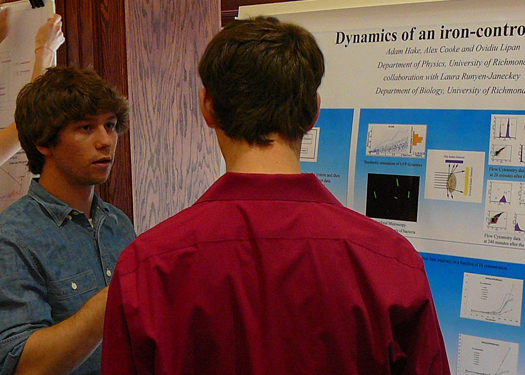
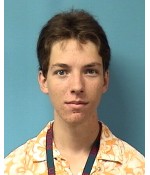 Physics majors Ben Pauerstein, ’12, and Cain Bonniwell, ’11, traveled to Kona, Hawaii this fall to present their research at the national conference of the American Physical Society’s Division of Nuclear Physics. The two are working with Professor Con Beausang, studying nuclear structure in the isotopes Gadolinium156 and Terbium 155.
Physics majors Ben Pauerstein, ’12, and Cain Bonniwell, ’11, traveled to Kona, Hawaii this fall to present their research at the national conference of the American Physical Society’s Division of Nuclear Physics. The two are working with Professor Con Beausang, studying nuclear structure in the isotopes Gadolinium156 and Terbium 155.
New $160,000 supercomputer coming!
Two physics faculty members, Ted Bunn and Jerry Gilfoyle, have just been awarded a $160,000 grant from the National Science Foundation to buy a new supercomputing cluster for their research. Ted and his students will use it to simulate new telescopes that are being designed for observations of the cosmic microwave background radiation. Jerry and his students will use it for simulation and analysis of nuclear physics data from Jefferson Lab.
Both faculty members are excited about the new research directions that this will allow them to explore, and especially about the opportunity for students to be involved with research using cutting-edge supercomputing equipment.
Physics courses for new first-year students
It’s time for incoming first-year students to register for classes for the fall semester. We in the physics department are looking forward to meeting you all in the fall.
Here’s some information about the physics courses available for new students. If anything here isn’t clear, or if you have any questions about which course is for you, ask us!
Physics majors typically start with Physics 131 in the fall and either 132 or 134 in the spring. There are four sections of physics 131 available this fall. Physics 131 is mostly about mechanics but has some other topics as well. It requires either that you’ve had some calculus or that you take Calc. 1 at the same time.
Pre-med students and students in other science majors also take this same sequence of courses, and the course fulfills the science requirement for non-science majors, so even if you’re not sure what you’re majoring in, keep this course in mind.
Students with strong high school physics backgrounds can skip Physics 131 and start right away with Physics 132. There is one section of this course offered in the fall. University policy says that you need a 4 or 5 on the Physics C Mechanics, or departmental permission, to skip Physics 131. If you have a strong physics background but didn’t take the right AP exam, email us or talk to one of the physics faculty when you arrive in town to see if you should be in 132. (This applies especially to international students, who aren’t part of the US AP system.)
If you think you might want to major in physics (even if you’re not sure), and you’re eligible to skip 131, we strongly urge you to sign up for Physics 132 in the fall. Finishing the introductory physics sequence early will give you a lot more scheduling flexibility in future semesters (and remember that even if you end up majoring in another science, you’ll still need to take this course).
Students with very strong physics backgrounds (a 4 or a 5 on the Physics C: Electricity & Magnetism AP exam) are eligible to skip both semesters of the introductory sequence. If you’re in that category, and you think you might want to study physics, the best courses for you are Physics 205 (Modern Physics) and/or Physics 301 (Mathematical Methods). Once again, if you didn’t take the appropriate AP exam but think you might have the right background for this option, ask us.
For students who aren’t planning to major in a science, we offer Physics 125, a survey of conceptual physics. This course fulfills the general-education science requirement, but it does not fulfill prerequisites for more advanced science courses.
New telescope
Our department just took delivery of a new 14€³ telescope, to be used for classes, student projects, and public observing nights:
As you can see, it's not in the best possible observing location at the moment. Plans are in motion to give it a permanent home on the roof of our building.
Thanks a lot to Dean Newcomb for buying us this!
Andrew Hearin, '03
UR Physics alumnus Andrew Hearin, ’03, went off to graduate school in mathematics, but before too long he saw the light and returned to physics. He’s now a Ph.D. student at the University of Pittsburgh, and he just recently published a paper on a possible novel test of general relativity. (That link is to a publicly-available preprint version of the paper. Here’s the actual published version, but the link may not work unless you’re connecting from a university with a subscription to the journal.)
Welcome, admitted physicists and engineers!
If you are a newly admitted student planning to attend Richmond in fall 2009, please drop us a line! We like to stay in touch with potential physics and engineering students over the summer, to pass on information on course selection and research opportunities. (Probably only a couple of notes over the summer; we promise not to flood your inbox.) Please drop a quick note to Matt Trawick, and we’ll put you on our contact list. Welcome, class of 2013!
2009 UR student symposium highlights undergraduate research
Last week all UR students doing original research had a chance to share their work with others at Richmond during the 2009 student symposium. As usual, the physics department was well represented, with nine students presenting posters of their work, on topics ranging from cosmology to biological physics. Afterwards, the Society of Physics Students organized “Sky Watch,” during which all of the symposium participants could get a taste of astronomy and see the night sky through telescopes.
Evolution and entropy
Researchers tend to get very specialized, working mostly in just one area. But every once in a while, it’s fun for a researcher to work on something completely different. UR Professor Ted Bunn, who normally does astrophysics, just had an article accepted for publication that talks about biological evolution and its relationship to the laws of thermodynamics.
Believers in creationism and intelligent design sometimes say that Darwinian evolution is impossible, because it conflicts with the second law of thermodynamics. The second law says, very roughly, that the total amount of disorder (or entropy) in the universe always increases, so, the creationists say, it’s impossible for the orderliness of life to arise spontaneously. This argument is wrong — there’s no conflict between evolution and thermodynamics. The point of this article is to explain exactly why it’s wrong.
Visiting UR? Yes, you CAN sit in on a physics class!
If you are a prospective physics student visiting UR this spring, we would be happy to let you sit in on a physics class! It’s a great way to get a feel for what a Richmond physics class is really like. To set up a classroom visit, please contact our department admin, Mary Ann Stewart. (During the fall, classroom visits are arranged centrally by the UR admissions office. They don’t do it during the spring, presumably to avoid unmanageably large numbers during that busy time. But as usual, the physics department doesn’t play by the rules; we’re small enough that we can welcome visitors anytime if you contact us directly.)
Cosmology research at Richmond
 A couple of the students in Ted Bunn’s research group published papers recently on their research in cosmology. You can find more details about their work in some posts on Ted’s blog.
A couple of the students in Ted Bunn’s research group published papers recently on their research in cosmology. You can find more details about their work in some posts on Ted’s blog.
Junior Austin Bourdon and Bunn published a paper analyzing some puzzling results from the WMAP satellite. WMAP is a NASA-funded orbiting telescope that has mapped the cosmic microwave background radiation in great detail.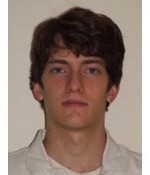 This radiation is the oldest light in the Universe and tells us a lot about conditions shortly after the Big Bang. Some features of these maps appear inconsistent with the best theoretical models. Austin and Bunn tried to search for alternative explanations. The paper was accepted for publication in the journal Physical Review D. Bunn wrote a bit more about it in this blog post, or if you really want the details you can read the paper. (Use the link at the upper right to download the PDF if you want the whole thing.)
This radiation is the oldest light in the Universe and tells us a lot about conditions shortly after the Big Bang. Some features of these maps appear inconsistent with the best theoretical models. Austin and Bunn tried to search for alternative explanations. The paper was accepted for publication in the journal Physical Review D. Bunn wrote a bit more about it in this blog post, or if you really want the details you can read the paper. (Use the link at the upper right to download the PDF if you want the whole thing.)
Senior Brent Follin worked with Bunn and a former graduate student at the University of Wisconsin 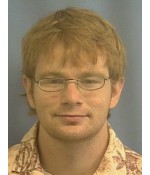 on another project having to do with the microwave background radiation. The cosmology group at UR is working with researchers at several other universities on a radically new design for a telescope to map the microwave background radiation. This telescope will be an interferometer, which really means a set of many very simple telescopes, combined with a mechanism to “mix” the light from all of them together. It’s a bit tricky to do this mixing in such a way that it’s possible to extract all of the useful information at the end. The three researchers managed to solve an important part of this problem and published the result in the journal Monthly Notices of the Royal Astronomical Society. Bunn blogged a bit about this work when we first submitted it. You can read the article if you want to.
on another project having to do with the microwave background radiation. The cosmology group at UR is working with researchers at several other universities on a radically new design for a telescope to map the microwave background radiation. This telescope will be an interferometer, which really means a set of many very simple telescopes, combined with a mechanism to “mix” the light from all of them together. It’s a bit tricky to do this mixing in such a way that it’s possible to extract all of the useful information at the end. The three researchers managed to solve an important part of this problem and published the result in the journal Monthly Notices of the Royal Astronomical Society. Bunn blogged a bit about this work when we first submitted it. You can read the article if you want to.
Carrie Zegetosky '07: engineering with concrete
 Caroline Zegetosky graduated from Richmond in spring of 2007, having completed the Engineering dual degree program. She spent her first three years at UR, then continued as an undergraduate engineering student at the University of Virginia, one of our partner schools, where she is now a graduate student in civil engineering. Carrie uses the same atomic force microscopy techniques she learned here at UR to study the microstructure of different types of concrete, creating images such as the one to the right. (Nice pics, Carrie!)
Caroline Zegetosky graduated from Richmond in spring of 2007, having completed the Engineering dual degree program. She spent her first three years at UR, then continued as an undergraduate engineering student at the University of Virginia, one of our partner schools, where she is now a graduate student in civil engineering. Carrie uses the same atomic force microscopy techniques she learned here at UR to study the microstructure of different types of concrete, creating images such as the one to the right. (Nice pics, Carrie!)
Jim Stith speaks about careers in physics
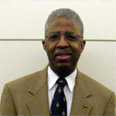 Jim Stith, recently retired as Vice President, Physics Resources Center for the American Institute of Physics, spoke at the University of Richmond about careers for physics students. The title of his talk was “The Physics Passport – Where does it take you?” Jim points out that of the 5500 yearly graduateswith bachelors degrees in physics, only a small number continue a “traditional path” of academic physics research. Many more continue in industry and government sector work, where their technical backgrounds and problem solving skills allow them to address a variety of challenging problems in different areas. Before coming to AIP, Dr. Stith was a Professor of Physics at The Ohio State University and also spent 21 years on the faculty of the United States Military Academy at West Point.
Jim Stith, recently retired as Vice President, Physics Resources Center for the American Institute of Physics, spoke at the University of Richmond about careers for physics students. The title of his talk was “The Physics Passport – Where does it take you?” Jim points out that of the 5500 yearly graduateswith bachelors degrees in physics, only a small number continue a “traditional path” of academic physics research. Many more continue in industry and government sector work, where their technical backgrounds and problem solving skills allow them to address a variety of challenging problems in different areas. Before coming to AIP, Dr. Stith was a Professor of Physics at The Ohio State University and also spent 21 years on the faculty of the United States Military Academy at West Point.
25 Random things about UR Physics
- The introductory physics courses are all small: capped at 24 students, though usually much smaller.
- Upper level physics courses are even smaller: usually no more than about 10 students in a class.
- We don't have any graduate students! Undergrads are taught by professors, and get to use all the cool equipment themselves.
- Intro physics courses are taught in a "workshop style," where laboratory and classroom elements are integrated together. (No separate 3-hour labs, taught by grad students, that aren't related to the lectures.)
- Favorite study break: liquid nitrogen ice cream!
- About 6-10 physics students graduate each year.
- All of the tenure-line physics faculty are active researchers, making discoveries and publishing their findings€”all with the help of undergraduate students.
- Do the math: with a small number of majors and lots of research to be done, all students have a chance to get involved, usually by their sophomore years.
- First year students can get involved in research too: at least 8 of them, so far this year.
- 100% of the physics faculty have external funding for their research. (This means their research is recognized as important in their field. It also means more money and opportunities for their students.)
- Students doing research have coauthored papers with faculty in prestigious scientific journals.
- Students frequently travel to national and international scientific conferences to present their work. (Some recent destinations: Los Angeles, Denver, Hawaii, Alaska, St. Louis, Oakland€¦)
- Many of our physics students also study abroad: (Scotland, China, Australia€¦)
- Many students do research here over the summers, paid by external grants (NSF, etc.) or University fellowships.
- Many physics students are double majors, with a second major in math, computer science, chemistry, biology, political science, philosophy€¦.
- Students can graduate with either a B.S. or B.A. degree in physics. (The B.S. prepares you better for grad school or a technical career; the B.A. offers more flexibility for students with other interests.)
- Favorite physics student hangouts: either the physics student lounge, or any open classroom.
- Best place to watch major sporting events: on the projection TVs in the classrooms after hours.
- Our 3-2 engineering program offers students chance to do 3 years at Richmond, followed by 2 years at a partner engineering school. (Students have also gone straight to grad school in engineering after graduating with a straight-up physics degree.)
- Our resources include a state-of-the-art atomic force microscope and a supercomputer cluster, among other major instrumentation, plus very well equipped teaching laboratories.
- Most heavily used physics equipment: the coffee maker. (It's not even close.)
- After graduation, some students have gone on to physics graduate school (University of Chicago, University of Kentucky, Princeton, Johns Hopkins€¦)
- Other students have followed their dreams elsewhere after graduation: teaching English in China, doing software development in industry, actuarial mathematics, high school teaching….
- Physics students are really friendly! They study together and help each other, and the atmosphere is always fun and supportive.
- We like meeting new physics students. If you’re interested in physics, please come to visit us. 🙂
Emily Nelson ’12: Research Update
 First year student Emily Nelson has recently begun work on a research project with professor Matt Trawick that seeks to improve the accuracy of atomic force microscope images. The atomic force microscope in Trawick’s experimental research lab, a $200,000 instrument, is capable of resolving features on the scale of about one nanometer in size, about 1000 times smaller than conventional optical microscopes. Emily is working to correct for a particular kind of image distortion that is common to such microscopes; the correction would allow these instruments to be used for sub-nanometer precision measurements in three spatial dimensions, and would be broadly useful to researchers in a variety of fields. Emily expects to major in computer science, and also has interests in biology and the physical sciences.
First year student Emily Nelson has recently begun work on a research project with professor Matt Trawick that seeks to improve the accuracy of atomic force microscope images. The atomic force microscope in Trawick’s experimental research lab, a $200,000 instrument, is capable of resolving features on the scale of about one nanometer in size, about 1000 times smaller than conventional optical microscopes. Emily is working to correct for a particular kind of image distortion that is common to such microscopes; the correction would allow these instruments to be used for sub-nanometer precision measurements in three spatial dimensions, and would be broadly useful to researchers in a variety of fields. Emily expects to major in computer science, and also has interests in biology and the physical sciences.
Sarah Atwater ’09: Research Update
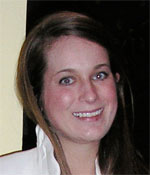 Senior Sarah Atwater is now working with professor Matt Trawick, studying the formation of vortices in a fluid as it is drawn over a surface in flow coating, a technique used to prepare thin polymer films. They are examining whether vortex formation may be responsible for observed defects in resulting films. Sarah began doing research during her sophomore year, analyzing angular correlations in molybdenum nuclei with professor Mirela Fetea.
Senior Sarah Atwater is now working with professor Matt Trawick, studying the formation of vortices in a fluid as it is drawn over a surface in flow coating, a technique used to prepare thin polymer films. They are examining whether vortex formation may be responsible for observed defects in resulting films. Sarah began doing research during her sophomore year, analyzing angular correlations in molybdenum nuclei with professor Mirela Fetea.
Berta Darakchieva ’09: Research Update
 Berta spent her summer working at both Lawrence Berkeley National Laboratory and Yale University with Richmond Professor Con Beausang. Berta worked on two different projects: the first involved calculating transmission efficiency and count rates for detecting fission fragments at the focal plane of the Berkeley gas filled separater. The second involved analyzing data from an experiment done in Berkeley to populate low spin excited states in Gadolinium 154. Berta began working with professor Beausang as a freshman, and continues working with him this academic year.
Berta spent her summer working at both Lawrence Berkeley National Laboratory and Yale University with Richmond Professor Con Beausang. Berta worked on two different projects: the first involved calculating transmission efficiency and count rates for detecting fission fragments at the focal plane of the Berkeley gas filled separater. The second involved analyzing data from an experiment done in Berkeley to populate low spin excited states in Gadolinium 154. Berta began working with professor Beausang as a freshman, and continues working with him this academic year.
Whitney Brooks ’09: Research Update
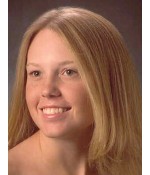 Whitney Brooks split her summer between Lawrence Berkeley National Laboratory and Yale University, working with Richmond professor Con Beausang. Whitney investigated “pile-up effects” in preamplifier output pulses from the prototype detector for the GRETINA array, the next leading US gamma ray microscope. Whitney continues her work this academic year.
Whitney Brooks split her summer between Lawrence Berkeley National Laboratory and Yale University, working with Richmond professor Con Beausang. Whitney investigated “pile-up effects” in preamplifier output pulses from the prototype detector for the GRETINA array, the next leading US gamma ray microscope. Whitney continues her work this academic year.

